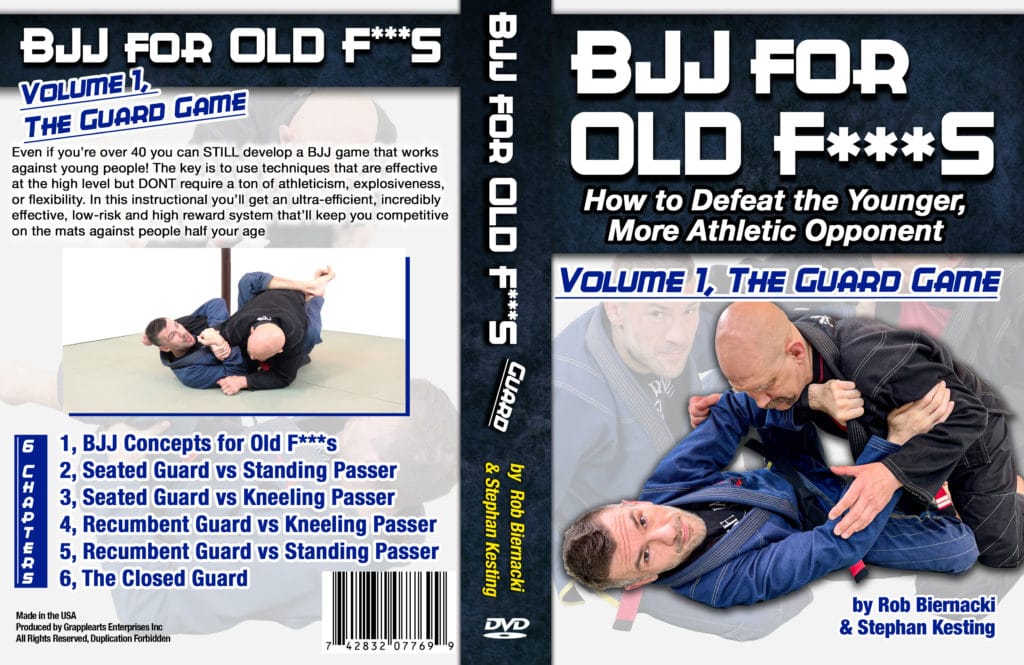If you’re an older grappler playing guard against a standing opponent then you should start in the seated or butterfly guard rather than starting flat on your back.
Sitting up will give you the best chance of getting your grips and setting up your preferred guard of choice.
If you lie down into a recumbent guard (i.e. with your back flat on the floor) then you’re essentially conceding the engagement phase of guard. And that means you’ll need a lot of leg dexterity and flexibility to avoid getting your guard passed.
This strategy is explained in detail in this video here and in the article below…
Let’s review some of the key points of this video…
THE ENGAGEMENT PHASE OF GUARD
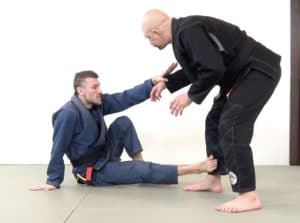
The engagement phase of guard, fencing for dominant grips and angles
The engagement phase of guard is the time during which both players attempt to secure their first set of dominant grips.
Whoever wins the engagement phase – top or bottom – then has a significant advantage in the next exchange, be that pursuing a sweep, a guard pass, a submission, etc.
Many clubs neglect this phase of the guard, and many people will just start in a pre-defined guard position and then go from there. Starting like this is fine once in a while, but if this is all you do then you can get surprised if you compete or go against someone who doesn’t accept you getting your initial preferred grips and hooks.
Some guard passers prefer to start standing, whereas others prefer to pass on their knees. As a huge generalisation, standing passers tend to rely more on speed and mobility based guard passes, whereas kneeling passers tend to rely more on pressure passing.
You need to have effective strategies against both kneeling and standing passers.
RECUMBENT GUARD
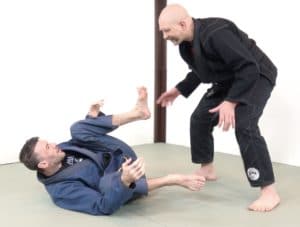
Recumbent guard vs a standing opponent in the engagement phase – no grips
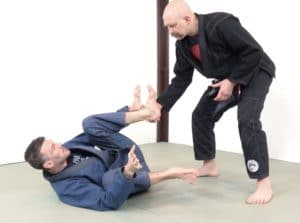
The opponent (in black) makes a grip
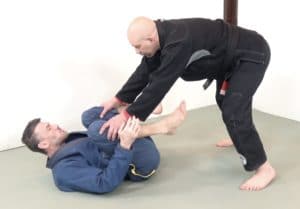
Opponent gets very secure double grips
If you start a match flat on your back against a standing opponent then you’re probably going to lose the engagement phase.
That’s because your partner can come up and get his choice of grips on your feet, your ankles, or your shins. Once he has that control he’ll be using dynamic passes like the toreando and the leg drag putting you into guard retention mode. Now you’ll be fighting to stop your opponent from passing your guard while trying to establish a more dominant form of guard yourself.
Recumbent guard retention is made a lot easier by being young, bendy, and flexible. Younger players can high leg with ease, invert into Granby rolls, and do all the other cool stuff required for high level guard retention from your back.
But that’s not an issue once you’re dealing with stiff hips, inflexible hamstrings, and tight backs, all of which will interfere with effective guard retention and result in you getting smashed.
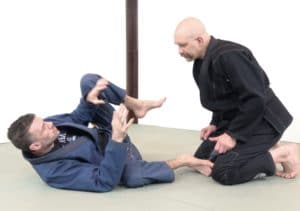
Recumbent guard vs kneeling opponent engagement phase
An important distinction is that it’s OK to use a recumbent guard if your opponent is kneeling!
People on their knees don’t move as fast, allowing you to set up layers of frames to deal with their guard passing and guard smashing attempts, making recumbent vs kneeling a feasible strategy for older grapplers.
Key point: most older players should NOT use the recumbent guard in the engagement phase if their opponent is standing.
SITTING GUARD
Older folks should start a guard engagement phase battle sitting up. That’s because sitting up against a standing opponent gives the older grappler a MUCH better chance of winning the critical engagement phase.
B sitting up and keeping your hands in front of your legs you can now use your hands to win the gripfight. You’re NOT relaying on hip and leg flexibility, instead you’re able to use your hands and arms to fend off his gripping attempts.
Once you’ve established a dominant grip you can then move into an even more dominant form of control like the shin-on-shin position, the outside single leg position, single leg X guard, etc.
A quick note about the importance of matched vs unmatched leads…
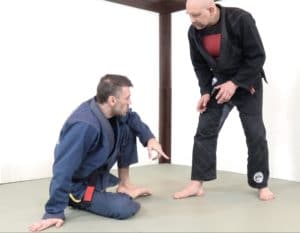
Unmatched leads: left foot forward vs right foot forward
In general, if you’re sitting up with one leg forward then you should aim to have an unmatched lead situation. For example, if your opponent is leading with his right foot then you want to have your own left foot forward.
This unmatched lead situation is what you want to achieve.
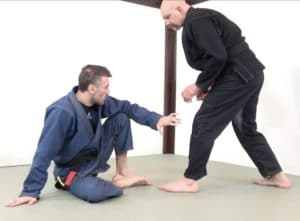
Matched leads can be dangerous for the bottom man
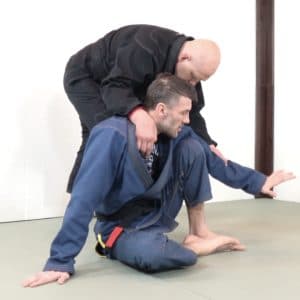
Because the top man can quite easily circle to your back
If you use a matched lead (e.g. right vs right, or left vs left) then you’re exposing yourself to needless danger. All he needs to do is take a single giant step forward with his rear leg and – BOOM – he’s on your back.
GRIPFIGHTING SEQUENCES
Winning a dominant first grip is probably the single most important thing you can do to make sure a match is going to go your way.
Fortunately sitting up allows you to engage in very effective gripfighting.
The following gripping sequence is but one of many possible strategies. That being said, it works equally well in gi and no gi gripfighting, so you should probably incorporate it into your arsenal of strategies.
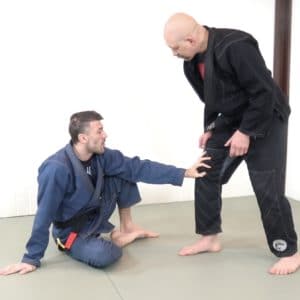
Sample gripfighting sequence 1: frame on your opponent’s leg
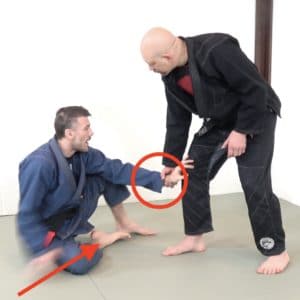
2, He controls your wrist, move to intercept
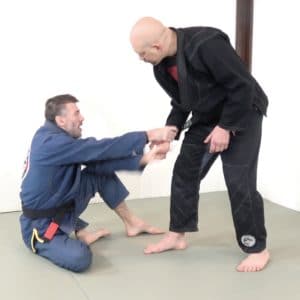
3, Control his wrist and free your own
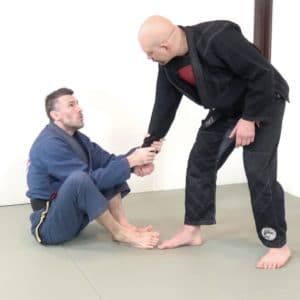
4, Move into double wrist control
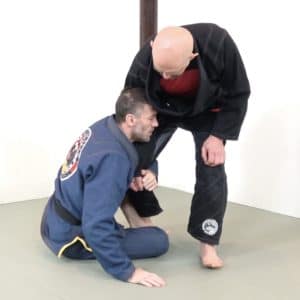
5, Use the double wrist grip to transition into an even more dominant control position
MORE GUARD STRATEGIES VS YOUNGER PLAYERS
The latest Grapplearts instructional BJJ for Old F***s has a TON of solutions for older grapplers hoping to achieve an efficient, safe, and effective guard. They include…
- How to establish control over an younger guy trying to sprint, dance and dive around your guard
- Strategies to beat faster opponents by setting them up so you can predict exactly what they’re going to do… and then beat them to it
- An extensive, very efficient, but low-energy guard retention system (in Volume 3)
- The exact training methods and drills you can do that’ll allow you to get better as fast as possible, with a much lower chance of injury
- Sweeps that are very high percentage but require almost no athleticism
- Submissions that’ll tap out the young studs but won’t put you in a compromising position if everything goes wrong
- And a ton of other techniques and strategies learned from decades of hard-won experience on the mats. We’ve suffered and broken ourselves so that you don’t have to!
Check out the brand new Grapplearts instructional BJJ for Old F***s. It’s available in app, DVD, and online streaming formats and is covered by my unconditional 365 day moneyback guarantee!
I’ll say that, without any reservations, that it’s really good and will definitely improve your effectiveness and longevity on the mats if you’re age 40 or older!
Stephan Kesting
The post Why Older, Slower, Stiff, and Broken Grapplers Should Use the Butterfly Guard Against Standing Opponents appeared first on Grapplearts.

